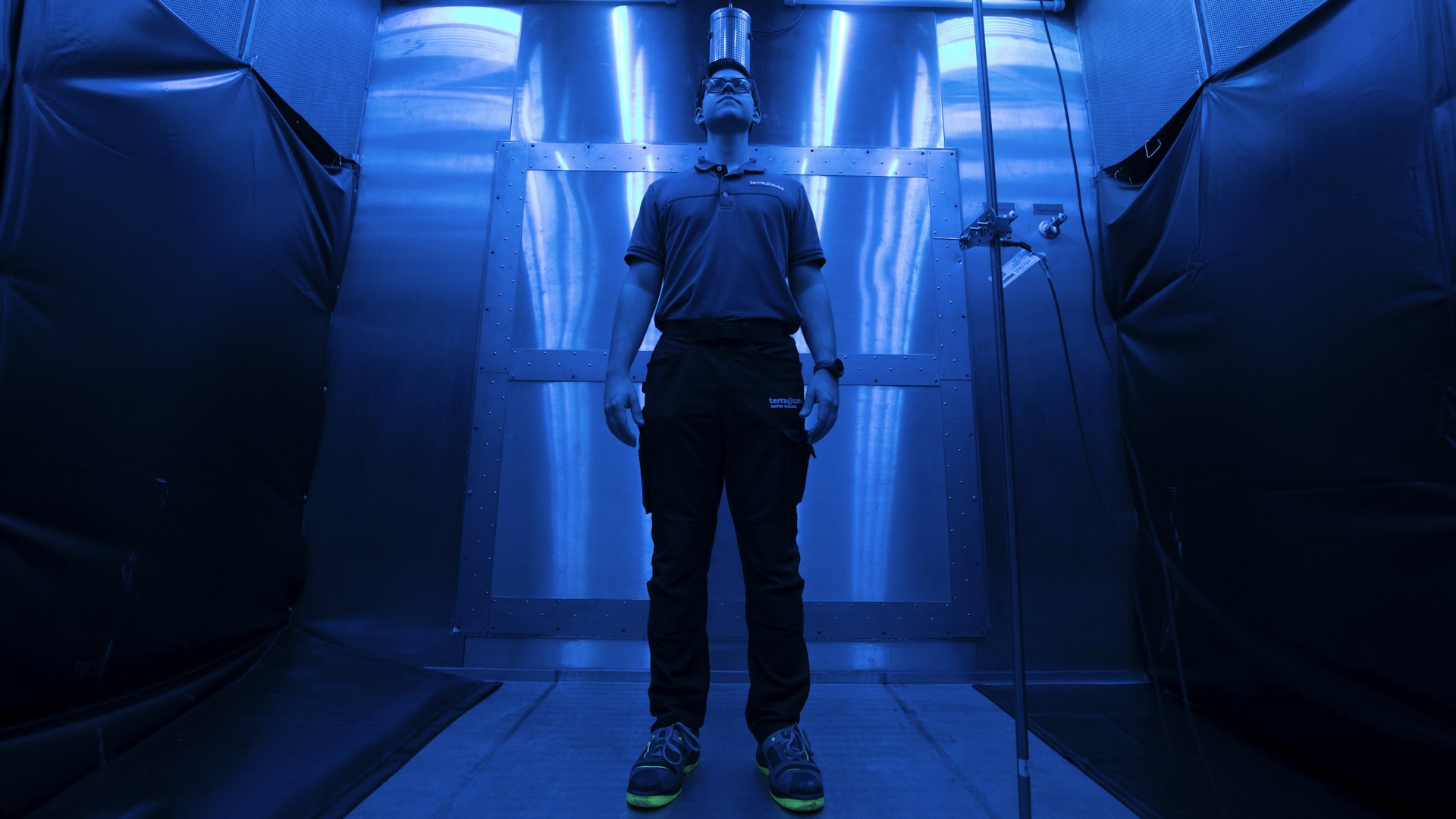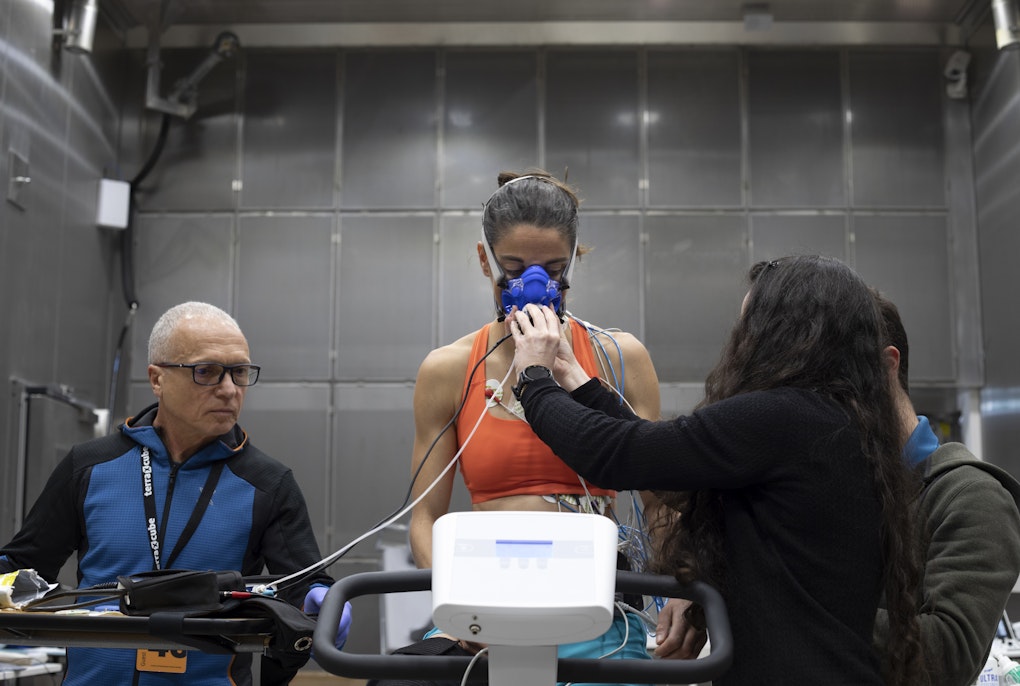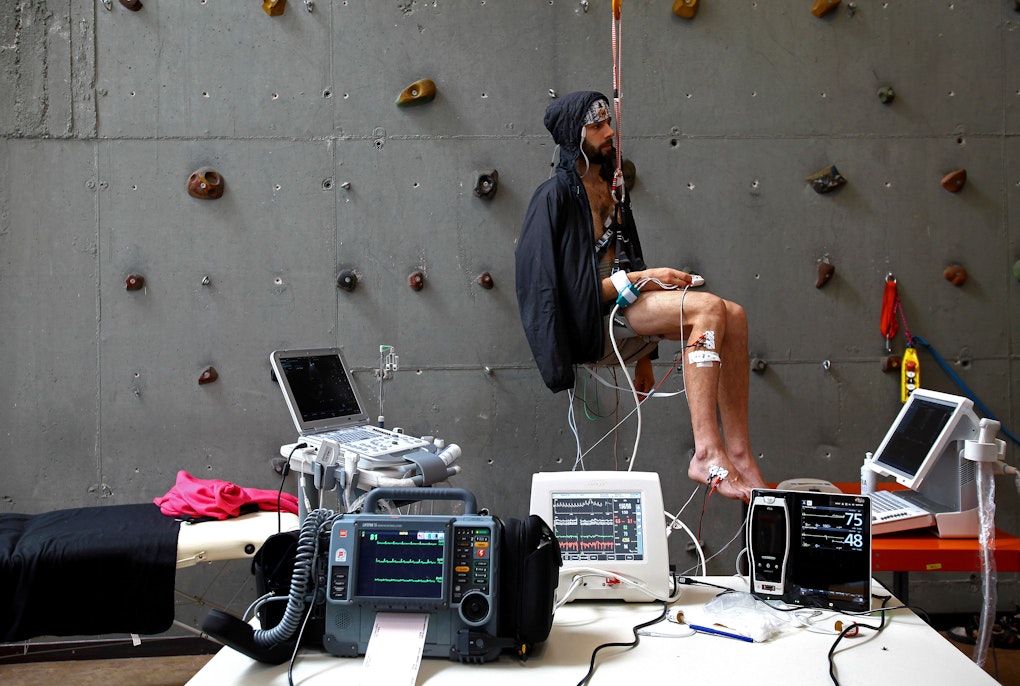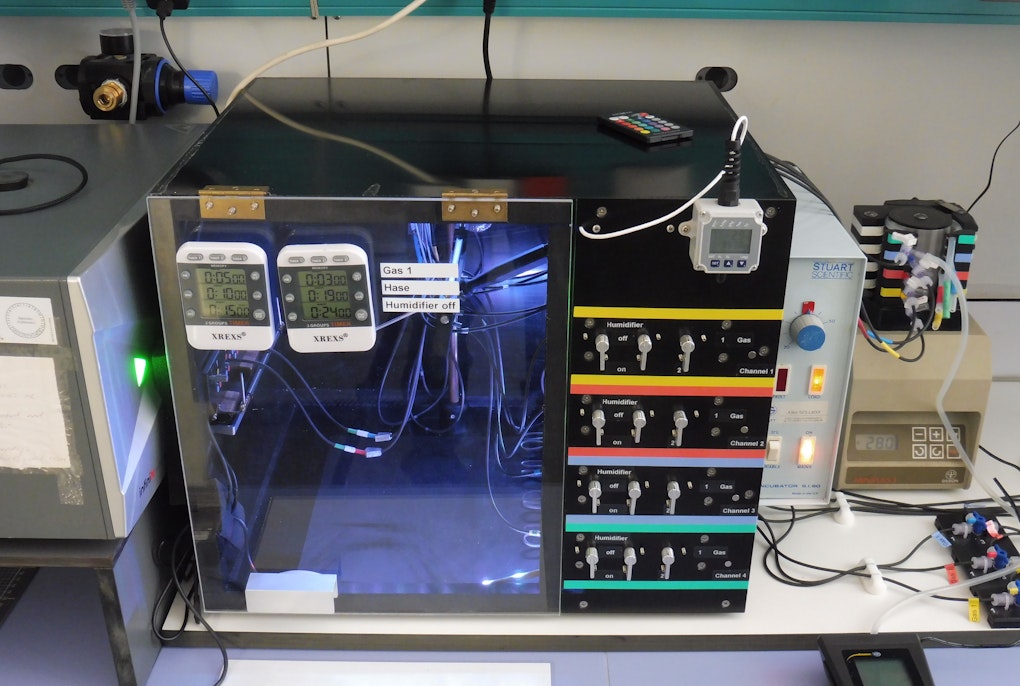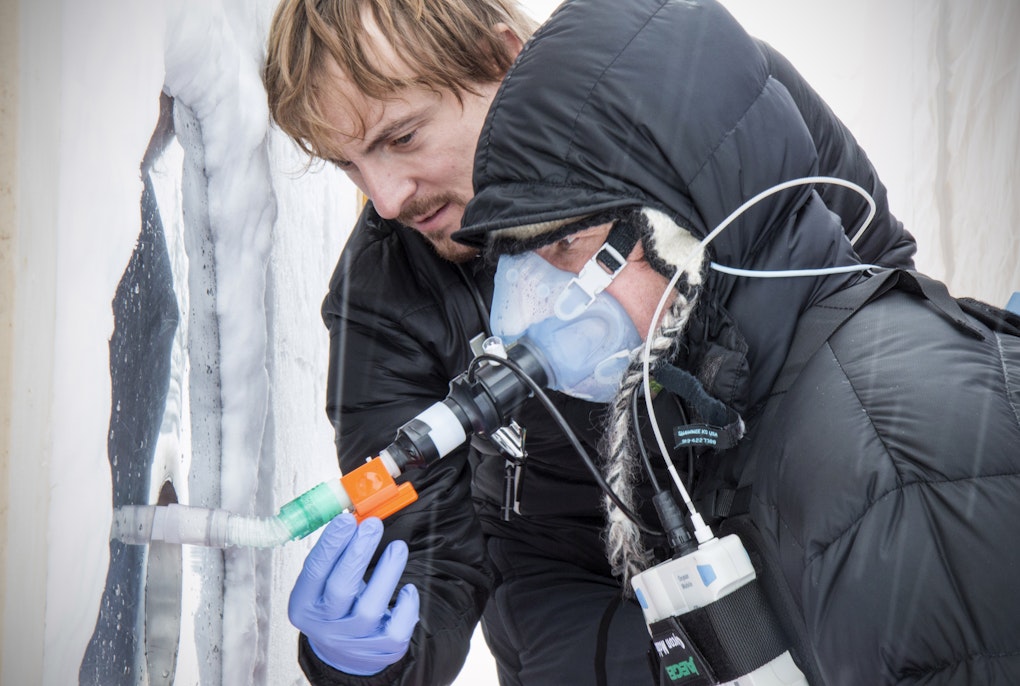magazine_ Reportage
How far can perception go?
Human sensory capabilities are being tested at terraXcube to find out
Andrea Eccher, terraXcube technician, in one of the climatic chambers in which the experiments on human perception take place.
Credit: Eurac Research | Andrea De Giovanni
What are we able to sense about the environment around us? And specifically, how sensitive are we to temperature changes? To find out, doctoral student Laura Battistel uses the terraXcube, an extreme environment simulator. I served as a guinea pig in one of her experiments, here’s what I discovered.
Do we really know what our bodies are capable of? Judging by the expression on the faces of Laura Battistel’s colleagues when she tells them the results of her experiment, one would say no. Battistel, a PhD student in cognitive and brain sciences at Eurac Research, has identified that the difference in environmental temperature that humans are capable of perceiving on average is 0.92 degrees Celsius. This means that, going from one room which has a temperature of 23 degrees to another of 23.9 degrees, we would be able to tell that the second room is warmer than the first. Furthermore: none of us would be wrong. This is what emerges from the study Laura is conducting in the terraXcube, Eurac Research's extreme environment simulator. Her results were recently published in a scientific paper in the journal Scientific Reports. And today I am right here, in the basement of the terraXcube, to experience for myself exactly what it means to contribute to Laura’s research and put my own sensory perception to the test.
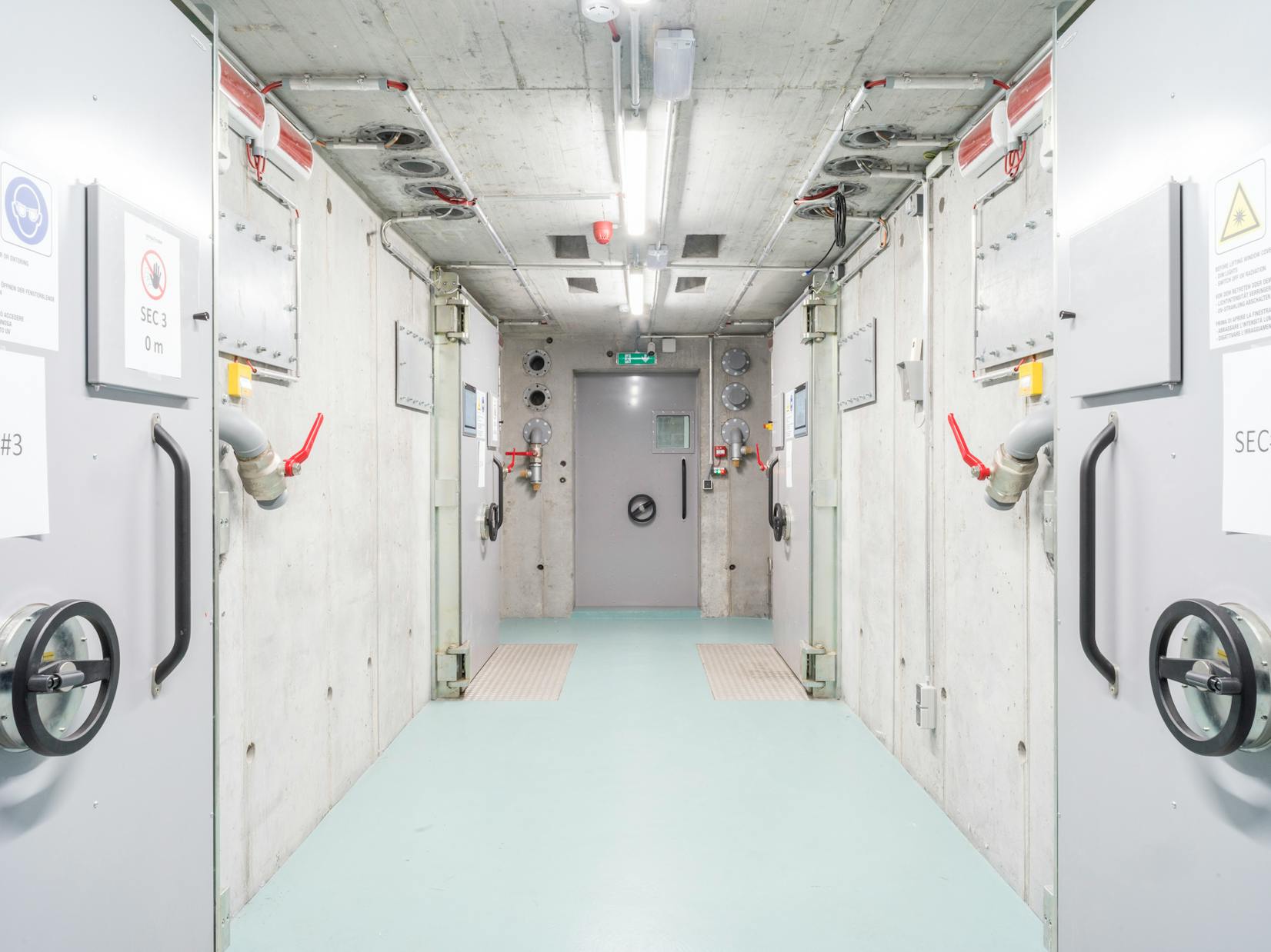 Credit: Schirra/Giraldi | All rights reserved
Credit: Schirra/Giraldi | All rights reservedThe Small Cube is one of the three environmental simulation areas the terraXcube is divided into. The ceiling traversed by a myriad of tubes, the metal walls, the dazzling white lights, air vents, buttons and lights on the walls evoke the Nostromo, the spaceship on which the hapless protagonists of the movie Alien voyaged through Space. Here, inside four independent chambers, the most diverse of the world’s climatic conditions can be simulated: temperatures from -20 to 50 degrees Celsius, rain, and a simulated air pressure of up to 4000 m.a.s.l. However, we are not on the set of a science fiction movie, and no dangerous alien creatures roam in the Small Cube. Nevertheless, human imagination and ingenuity take shape here as well. I am in the control room, from where, through glass screens, one can see everything that is happening in the climate chambers and manage its environmental parameters. Laura is attaching sensors to my body: four of them are chips that measure skin temperature and humidity, while another detects heart and respiratory rates. I am instructed with a seemingly simple task: to move from one climate chamber to another, following the directions Laura is going to give me with a walkie-talkie. In each chamber I will have to focus on the ambient temperature. “Clear your mind,” Laura suggests. “Try listening to your body, kind of like you’re meditating.” After moving from one room to the other, I will have to come out and say whether the second one was warmer or cooler than the first. It would seem like a piece of cake, but I'm a little worried. “I'm not good at focusing, my head is always somewhere else,” I think. I am afraid of disappointing expectations and compromising Laura’s study – but, by the end of the day, I will find out how much I underestimate my body rather than my mind. A quick check of my body temperature and we begin. Laura leaves me alone in the short corridor that connects the four climate chambers, closing the heavy metal door behind her. A short time passes and the walkie-talkie in my hand croaks, only to return with Laura’s voice, “So, Andrea, are you ready?” “Ready,” I reply. “Good, then go into room number three.” I enter it, peeling back the plastic sheet separating it from the rest of the facility, and the temperature change is immediate. I feel the chill of the air on my face, at the level of my wrists and the back of my neck. Following Laura’s directions, I move to the center of the room, next to a metal rod filled with sensors. I have five seconds to go through each part of my body, trying to mentally note down the information each one will give me about the temperature of the environment. Predictably, I am distracted by the uniqueness of the place. I am in a steel cube with a brightly lit ceiling. It is not a place one happens to find themselves in every day. Abruptly interrupting my thoughts is Laura’s voice: “Okay Andrea, now move to room number one.” As I turn to leave, I find myself hoping that my body has recorded the information that was uploaded during the few seconds I was in the room. In any case, I reflect, if it did, I have no idea where that information is now. I walk down the hallway in the direction of room number one, trying to keep hold of information that I feel like I don’t even have, because it is not associated with a number, image or sound, maybe just the word “cold.” Yes, but how cold? More or less than the room I am about to enter? I peel back the cloth separating me from the second room and try to figure it out. Cold again. I reach the center of the room, stop and close my eyes to avoid distracting stimuli. The cold air creeps into my nostrils, travels along the exposed parts of my skin. Time is up: Laura intimates that I should leave the room and tell her whether the second room was warmer or colder than the first. Absorbed in my evaluations, I move the plastic sheet and return to the hallway. I press the button that allows me to transmit my voice to Laura’s walkie-talkie but I remain silent. The temperature difference I sensed was not such that I could confidently say which of the two rooms was warmer or cooler. Within a few moments, I try to retrace the sensations felt, verbalizing them. And suddenly, a word echoes in my mind, coming from who knows where. The word is “hot.” The second room was warmer than the first. I inform Laura of the verdict, although I have the feeling that I was not even the one who formulated it. The procedure is repeated for another pair of chambers and then another and then another, like this for two hours, with short breaks. Sometimes I am able to perceive a clear difference between the temperature of the chambers, other times I am forced to rely completely on instinct. In some cases I seem to respond by drawing lots but, as I am about to discover, this is most likely just an impression.
We are not aware of this bodily sensitivity we have until we put it to the test.
Laura Battistel, PhD student at Eurac Research and CIMeC
Experiment over, it’s back to the control room. As I free myself from the sensors, Laura asks me a series of questions about the experiment, then turns her attention to the computer in front of her. It’s time to take a quick look at the test results. I try to catch any signs of disappointment or disapproval in Laura’s face but she seems serene. “I hope I haven't messed up your study,” I venture. “Don't worry,” she replies peremptorily, meanwhile consulting the numbers appearing on her screen. Suddenly she interrupts herself and turns to me. A smile follows. “You did good,” she exclaims. I continue to stare at her without saying anything, waiting for more information. “You have a threshold for perceiving temperature differences of 0.7 degrees Celsius. This means that if there were a temperature difference of 0.7 degrees between two rooms, you would be able to tell which of the two rooms is the hottest and which is the coldest, with almost no mistakes.” I am stunned, and Laura notices. “It’s normal for you to be surprised. We are not aware of this bodily sensitivity we have until we put it to the test.” Laura also tells me that most of the participants in her study believed that the temperature difference between rooms reached up to five degrees Celsius or more. However, this difference never went beyond two degrees Celsius, yet the volunteers were always able to feel it. “Can I say I'm an X-man?” I joke. “Actually, it does seem that we are all endowed with this sensitivity to temperature changes. Among the participants in my study, there is very little variability. Your sensitivity is a little higher than average, but there were those who got even better results,” Laura answers. Too bad, I think, but at the same time I am amazed at how such a widespread characteristic could have gone unnoticed until now.
Knowing the threshold of human’s perceptibility of temperature differences could allow much less energy to be consumed for air conditioning in buildings.
Laura Battistel, PhD student at Eurac Research and CIMeC
I ask Laura what repercussions such a discovery might have on everyday life. “In our experiments we do not consider the thermal comfort of the participants. In the future, however, knowing the threshold of human’s perceptibility of temperature differences could allow much less energy to be consumed for air conditioning in buildings.” “How?” I ask her. “Well, imagine you are in a building maintained at a certain comfort temperature. Knowing your threshold of sensitivity to temperature changes, you could lower that temperature without feeling it and without falling below your comfort threshold, consuming less energy.” Laura’s experiments fit into the “Grounded Cognition” line of research. According to this scientific theory, the cognition we have of our surroundings is inseparably linked to our sensory perception of the world itself. In other words, when we reflect on something, try to recall a lived experience or approach our surroundings, our senses are activated and influence our thinking. To understand how our environment affects the way we think and behave, however, we must first find out what we are able to perceive. And this is what Laura is trying to do with her experiments. One of them includes using blue or red lights in order to assess whether the color of the environment we are in can affect our perception of temperature. The goal is to make the laboratory in which the study takes place as similar as possible to the environment in which we usually live. In everyday life, in fact, we are exposed to numerous stimuli that, by influencing each other, contribute to a cohesive perception of reality. Including multisensory stimuli in the experiment will, therefore, allow for results to be applicable to our daily lives. “In the future, we would like to create increasingly immersive environments, for example through the use of virtual reality. Then we will be able to understand how the various senses affect our perception of temperature,” Laura says. I leave the terraXcube and abandon the warmth of the building. Once on the street, a cool breeze creeps through the lapel of my jacket, making me shiver. The temperature change this time was most perceptible, and my body clearly signaled it to me. Returning to the car I linger on the passersby, aware that, most likely, none of them are aware of what I have just discovered thanks to Laura’s study. And the questions that arise spontaneously in my mind are: what else is our body able to sense without us being aware of it? In what and how many ways does the environment in which we find ourselves influence our being? Could even these reflections of mine be influenced by what I am perceiving at this instant? We like to shed light on places and phenomena light years away from us, but the greatest mysteries and their answers, may be contained inside us.
In this short video, Laura Battistel, a PhD student at Eurac Research and CIMeC, talks about her research project on environmental temperature perception.
The research project
The idea of studying human sensory abilities using the terraXcube is the brainchild of Massimiliano Zampini, a full professor at CIMeC, University of Trento. In her research, Laura Battistel, a PhD student in cognitive and brain sciences at Eurac Research, is supervised by Professor Massimiliano Zampini and Riccardo Parin, a researcher at the terraXcube. The goal of Laura Battistel’s doctoral thesis project is to find out what we are able to perceive about the environment around us. Only in this way, in fact, we can deepen our knowledge of how the environment influences the way we think and act.
